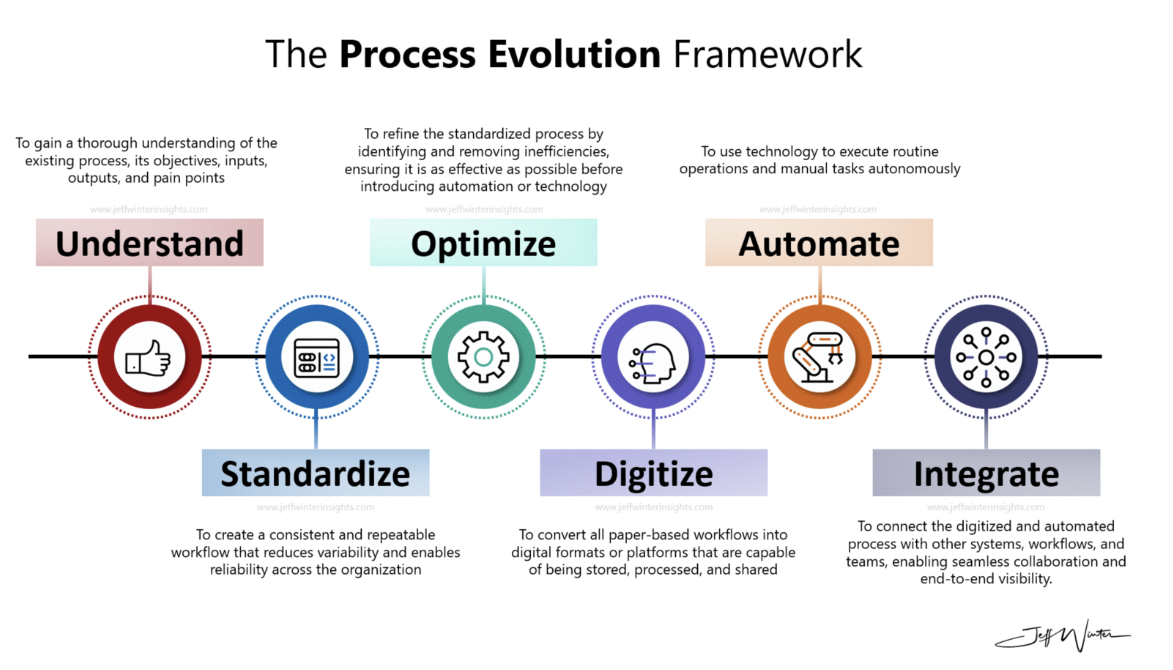Many teams roll out automation without a clear process evolution framework in place.
Image this: you rolled out automation.
Maybe it was a slick workflow tool, a data integration platform, or a robotic process. It promised efficiency, speed, and scale.
But what you actually got?
Frustrated teams. A few more dashboards. And processes that still break at the worst possible times.
This is what happens when you digitise chaos. When the underlying process is broken, technology doesn’t fix it—it magnifies it.
Many organisations fall into the same trap: they chase automation before understanding, cleaning up, and stabilising what they already do. It’s not a tech problem—it’s a process maturity problem.
That’s where the Process Evolution Framework comes in. Built on hard-won lessons and real-world results, it offers a clear, step-by-step path to help you move from process chaos to clarity—and only then, to smart automation.
In this article, you’ll learn exactly how to evolve your processes the right way—so when you finally do automate, it actually works.
What Is the Process Evolution Framework?

Before you automate, optimise, or digitise anything, you need to know what you’re actually working with. That’s the core principle behind the Process Evolution Framework.
At its heart, the framework is simple: it’s a structured way to improve processes step by step, so you don’t end up automating inefficiencies or scaling bad habits. It forces you to look at the reality of how work is done—then fix it—before layering on technology.
Here’s the problem most businesses run into: they’re in a rush to show results. So they skip over basic questions like:
- Do we even know how this process works, end to end?
- Is it done the same way every time?
- Where do the errors, delays, or breakdowns actually come from?
The Process Evolution Framework answers these questions in order. And that order matters.
It consists of five stages:
- Discover: Understand how the process is actually performed—not how it should be, but how it is today.
- Standardise: Create a consistent, repeatable version of the process. Eliminate unnecessary variations.
- Optimise: Improve the standardised process for speed, cost, accuracy, or whatever your goal is.
- Digitise or Automate: Only now do you bring in technology to scale or streamline the improved process.
- Monitor & Evolve: Build in feedback loops to keep improving over time.
It’s a maturity ladder. Not a checklist to rush through. And skipping steps? That’s where things go wrong.
Explanation of the 5 Step Process
Each stage of the Process Evolution Framework builds on the last. Skip one, and you risk building tech on top of unstable ground. Let’s walk through each stage.
1. Discover: See the Process for What It Really Is in the Process Evolution Framework
You can’t fix what you don’t understand. And most organisations assume far too much.
Discovery means mapping the process as it actually happens—warts and all. Not the idealised flow in someone’s PowerPoint, but the messy, real-world version with workarounds, handoffs, and breakdowns.
Key questions to ask:
- Who is involved at each step?
- Where are the delays or friction points?
- What triggers the process to start—and how does it end?
Why it matters: If you don’t uncover the true pain points, your optimisation or automation effort will fix the wrong problem—or miss it entirely.
2. Standardise: Create One Consistent Way in the Process Evolution Framework
Once you know how it works, you need to make sure it works the same way every time.
Standardisation removes unnecessary variation. This means documenting the process, training staff, and making it predictable.
What to look for:
- Are tasks being done differently by different teams?
- Do people know the “right” way to do things—or are they guessing?
- Can new staff follow the process without confusion?
Why it matters: You can’t improve what’s inconsistent. Automation thrives on predictability—without it, things fall apart.
3. Optimise: Make It Better Before You Make It Digital in the Process Evolution Framework
Only after you’ve created consistency should you improve efficiency. Optimisation is about tightening the bolts—cutting waste, reducing delays, streamlining steps.
Focus areas:
- Removing redundant approvals
- Consolidating steps
- Improving flow and eliminating wait times
Why it matters: Tech makes fast things faster. Optimising first means you’re not just digitising inefficiency—you’re amplifying performance.
4. Digitise or Automate: Scale What Works for the Process Evolution Framework
Now—and only now—is it time to bring in technology.
Digitisation means using tools to streamline manual steps. Automation means removing human input altogether where it’s safe and smart to do so.
Examples:
- Automating invoice approvals after they meet pre-set criteria
- Using software to route requests based on real-time data
Why it matters: When you automate after you optimise, you avoid scaling chaos and create real, measurable ROI. As noted in Mckinsey research, successful digital transformations are built on strong operational foundations—long before technology is applied at scale.
5. Monitor & Evolve: Build in Feedback Loops in the Process Evolution Framework
No process is perfect. Monitoring means tracking performance and collecting feedback to make continuous improvements.
Tools to consider:
- Dashboards and KPIs tied to process goals
- Surveys or feedback loops from users
- Root cause analysis for recurring issues
Why it matters: The real value of this framework isn’t one-time improvement—it’s continuous evolution.
Why Jumping Straight to Automation Fails in the Process Evolution Framework
It’s easy to see why automation is tempting. It promises speed, efficiency, and a modern edge. But when businesses skip the earlier stages of the Process Evolution Framework—especially discovery, standardisation, and optimisation—automation doesn’t solve problems. It scales them.
Here’s what typically goes wrong.
You Automate Variability
If different teams or individuals are executing the same process in different ways, automation will lock in one version—usually not the best one. This creates confusion, resistance, and failure points.
You Scale Inefficiency
An unoptimised process might be too slow, too manual, or too error-prone. Automating it just helps you get to those bad outcomes faster and more consistently.
You Misdiagnose the Problem
Without thorough discovery, you may automate a symptom rather than the root cause. The process still fails—but now it does so with greater speed and complexity.
You Undermine Trust in Technology
When automation causes more issues than it solves, users lose trust. Teams become reluctant to adopt future tools, assuming every new solution will just make their job harder.
The lesson is clear: skipping process maturity and going straight to automation may deliver short-term results, but it rarely creates long-term value. In most cases, it leads to rework, cost overruns, and disappointment.
When You Can Skip a Step and When You Absolutely Can’t in the Process Evolution Framework
Not every organisation has the time or resources to follow a five-step framework to the letter. And that’s fair. But some steps are foundational—cutting them almost guarantees failure. Others can be adapted or compressed depending on the situation.
Let’s break it down.
Steps You Should Never Skip
Discovery
No exceptions here. You must understand the current state before making changes. Even a quick discovery exercise—like process mapping with frontline staff—can uncover critical issues and inefficiencies. Skipping this means you’re operating blind.
Standardisation
Automation demands consistency. If your process varies wildly across departments or regions, tech will not fix that. It will hard-code the inconsistencies. Standardisation is what gives you control and predictability—prerequisites for any digital effort.
Steps You Can Adapt (With Caution)
Optimisation
In some cases, you may choose to automate before deep optimisation—particularly if the automation tool helps surface process data and user behaviour. But this is risky. You must go in with eyes open, knowing that post-automation optimisation will take longer and cost more.
Monitoring and Evolution
This step should never be entirely skipped—but it can be lightweight at the start. You might begin with a basic set of KPIs or a simple dashboard, then build out more advanced feedback loops over time. The key is to have some form of monitoring from day one.
When You Can Move Faster
If your process is already well-documented, tightly controlled, and widely adopted—say, a finance or HR workflow—you may be able to move more quickly through the framework. But even then, a quick validation of each step is essential.
The reality is this: the fewer shortcuts you take, the fewer problems you’ll deal with later.
How to Measure Success at Each Stage of the Process Evolution Framework
One of the biggest challenges with process improvement and automation is proving it’s working. Without clear metrics tied to each stage of the Process Evolution Framework, it’s easy to lose stakeholder buy-in or fail to catch problems early.
Here’s how to measure progress and success at each step.
| Stage | Goal | Key Metrics | Signs of Success |
| Discover | Understand the real, current process | – Number of undocumented steps found- Process gaps identified- Stakeholder participation | Hidden issues surface; process is understood beyond assumptions |
| Standardise | Create a consistent, repeatable process | – Reduction in variation- Number trained- Documentation completeness | Everyone follows the same steps; consistency achieved |
| Optimise | Improve efficiency and performance | – Decrease in cycle time- Fewer errors- Increased throughput | Faster process, fewer issues, higher output |
| Digitise and Automate | Use tech to scale or streamline the process | – Time/cost savings- User adoption- Manual steps eliminated | Tech is used properly, adoption is high, performance improves |
| Monitor & Evolve | Continuously improve and adapt | – Frequency of reviews- Number of improvement ideas- Trend in KPIs | Ongoing refinements; the process keeps getting better |
Clear metrics help you do more than justify the work—they help you manage it better. They also protect your projects from being labelled failures just because no one defined what success looked like.
The Biggest Takeaway
Technology isn’t a shortcut. It’s a multiplier. And if the process behind it is broken, inconsistent, or poorly understood, automation won’t fix it—it’ll make it worse.
That’s why the Process Evolution Framework matters. It forces you to slow down just enough to get things right before you speed them up. It ensures you’re solving the right problems, in the right order, with the right tools.
The message is simple:
- Don’t digitise until you’ve discovered.
- Don’t automate until you’ve optimised.
Whether you’re in operations, IT, or transformation, the framework gives you a path forward that reduces risk, improves outcomes, and earns trust.
So, the next time someone says, “Let’s automate this,” your first move shouldn’t be picking a tool. It should be asking: Is the process even ready?
For more on building strong digital foundation before automation, check out our article on Why Agility is Important to Building an Adaptive Business.




